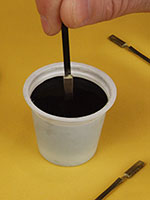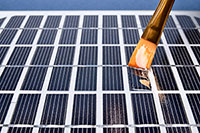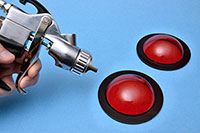
Dip Coating
Cost effective process provides uniform high quality coating on different shaped/sized substrates including large surface areas. Dip coating can be done manually or automatically for high volume production applications. Parts are immersed in a tank filled with a liquid polymer and then withdrawn at a constant rate at controlled temperatures/atmospheric conditions. Thickness of coating is determined by viscosity of coating, length of immersion, rate of withdrawal from tank and number of dipping cycles. Solidification often occurs at elevated temperatures in an oven. It is essential prior to dip coating that surfaces be free of contaminants. Flow and run off properties are important for process control and to meet consistent quality control standards.
With dip coating internal /external surfaces are coated at the same time. Select Master Bond eco-friendly liquid polymeric formulations are designed for long lasting protection against heat/cold, abrasion, corrosion, water, humidity, UV light, wind. They also enhance appearance and are available in a broad range of colors. Special coating grades are tough, optically clear, have low friction, guard against solvents/acids, resist vibration/impact and feature exceptional electrical insulation characteristics.

Brushing
Popular coating application method requires experienced personnel, proper brush/bristles for best leveling and distribution of the liquid polymer. Desired film thickness may need multiple coats. It is important that the synthetic or natural bristles of the brush are compatible with the product being applied. Size, shape, angle of brush should be considered for covering irregular surface areas such as edges, corners, boltheads, welds, piping. Brushes need to be clean prior to use.
While brushing has a short set up time, it is relatively slow compared to other coating techniques. Benefits include low wastage, low capital cost and economic suitability for short production runs.
Roll Coating
Paint rollers are used for manual application of coatings over large flat surfaces. Top quality roller covers and frames should be employed for best results. Master Bond roller coating is faster than brushing but does not perform well over surfaces that are textured or have bumps. Also it is difficult to control film thickness with a paint roller.
Automated roll coating equipment such as direct roller coaters, reverse rolling machines can effectively apply liquid polymeric coatings in uniform thicknesses to flat surfaces for high volume production. Some key parameters in selecting the proper machine include type of substrate, thickness/width of substrate, full/partial coat, speed of operation. A broad range of roll coaters are available in different configurations and offer cost effective, reliable, high quality finishes to meet diverse needs. This popular continuous energy efficient process requires less labor, reduces waste, has superior coating transfer efficiency, excellent weight control and allows design flexibility.

Spraying
Versatile, economical, fast coating process for different type, sized, shaped parts including large surface areas. Viscous/non-viscous liquid coatings can be applied manually/automatically with high transfer efficiency for uniform high quality finishes. Different types of spray guns and equipment such as airless spray, air atomized conventional sprays, air assisted airless sprays provide optimal material use and address individualized requirements including desired film thickness, quality of finish, reduction of overspray , edge buildups, wasted product concerns, reliable performance. Control of spray patterns, delivery rates depend on coating characteristics. Varied fluid delivery is designed to compensate for seasonal change of temperatures, humidity and allow spraying into recesses and cavities.
A key advantage of spraying is that it can be achieved from a vertical angle and helps provide a safe work environment. Common problems are sagging, orange peel, uneven spraying, pinholes, spluttering and overspray. Careful control features should be followed for good atomization and flow. Defective free coatings set high standards for spray application techniques and facilitate methods for transfer efficiency. Best spray pattern, spray distance/angle are necessary for smooth, outstanding finishes.
Spin Coating
Coating is applied in center of substrate and then spun at high speed by centrifugal force. Spin coater is rotated until finish has desired thickness. Viscosity, rate of spinning, spin time, acceleration, surface tension, resin materials, substrates are key parameters in meeting specific application requirements. Spin coating has proven highly effective in providing thin coatings, uniformity in thickness and consistent, repeatable quality of finish without variation. Spin coating process is simple, can be done rapidly and is used for coating across small/large sized substrates. Processing problems can include swirl patterns, uncoated areas, comets, streaks, too thin/too thick films. Nanosilica filled systems have played an integral role in improved ultrathin film quality.
Flow Coating
Flow coating is a fast, easy, reliable manual/automatic process for applying liquid coatings. It is recommended for use on large, flat horizontal sheets, panels which are difficult to dip coat. Additionally high coating thicknesses can be accomplished in only a single coat.
Flow coating is economical, requires little space, minimizes waste and has high transfer efficiency. Coatings are designed to be dispensed on the upper section of parts and flow down to cover the entire flat surface areas. This controlled gravity flow is a function of the viscosity of the compound. Curing conditions such as temperature/humidity will affect finish/uniformity. Flow coating is not desirable for parts with holes/pultrusions.
